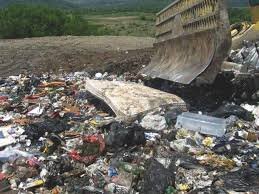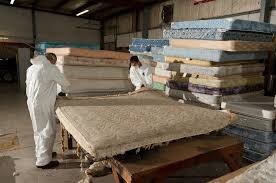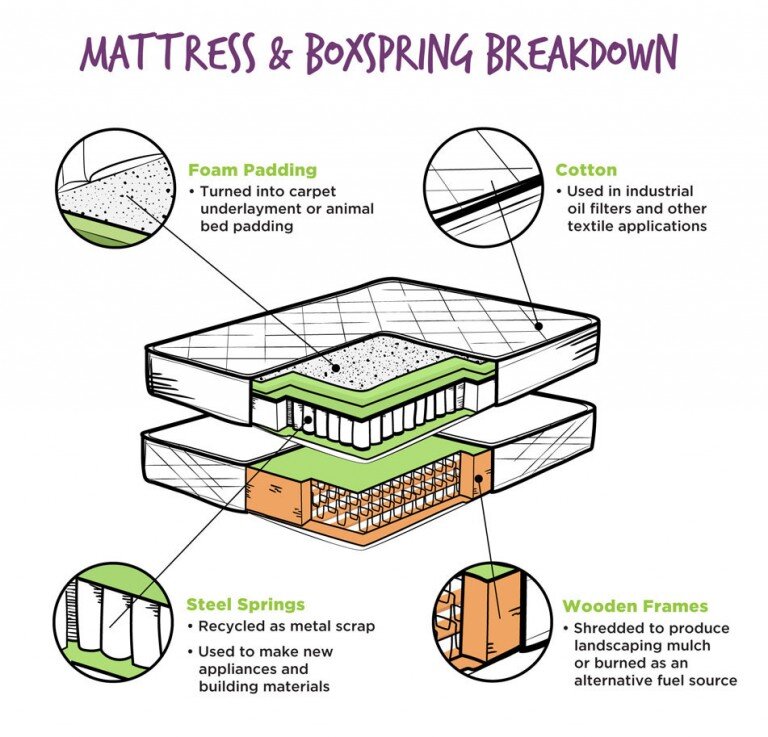How To Recycle Your Old Mattress | A Mattress Industry CEO And Bedding Expert’s Guide To Proper Mattress Disposal
Ever wonder what happens to a mattress that is returned after an unsatisfactory trial period, or when you dispose of that tired old mattress? Ever worry that you might receive a used mattress when you place an order for a brand new bed?
These are concerns that most consumers have when either buying or retiring an old mattress. Actually, most people really don’t give a second thought to what happens to a used mattress, though we receive a lot of emails wondering where they really go?
These days, consumers have a stronger sensibility about mattresses ending up in landfills, which sadly, is the graveyard for many hundreds of thousands of mattresses and will likely continue to be the easiest remedy. But changes are coming, and there are recycling efforts already operating in a big way to recycle every imaginable ingredient in a mattress.

Historically, when a mattress retailer has to pick up an old mattress to switch it out with a new one, or has to pick up a mattress that didn’t work out during a trial period, the company uses third party removal services to haul it away.
My company used to donate a large portion of our returned mattress up until about 2010 when there was a bedbug outbreak in New York City, that continues to this day. Most charitable organizations no longer accept used mattresses, and this shut down a huge channel for supplying people in need with mattresses that were, for the most part, in excellent condition.
Let me say that we would never ship out a used mattress to a customer who bought a new mattress, first because it is unethical, secondly because there are federal laws against this kind of thing, and lastly because a used mattress is probably instantly recognizable as new mattresses have a foam scent, whereas used mattresses quickly take on the scent of the owner. You don’t have to be a wolf with a supernatural sense of smell to tall them apart.
This kind of thing never happens in the real world, and any company that would dare try to do a less than ethical swap out, would be ruined instantly on social media, and be out of business in days.
When your mattress is picked up, the simple fact is in most cases, that retailers cannot afford to ship mattresses to a recycling facility and simply dispose of mattresses in land fills, much to the dismay of the trash haulers.
The last thing a waste management handler wants to get involved with is a pile of mattresses. Old mattresses are unsanitary, hard to handle, and do not easily compress or compost, and can actually damage garbage trucks mashing equipment.

Once dumped in the land fill, such things as non biodegradable materials, synthetic fibers, and the large amounts of chemicals used to build them, like fire retardants, adhesives, and polyurethane foams, could affect our earth leaching out into the ground water down the road.
Repurposing Mattress Components Into New Products
For years, our customers would as, “are there recycling companies that can recycle and repurpose a mattress?” Turns out there are many popping up in regional areas, especially big cities, and several states require that mattresses get recycled, including California, Connecticut and Rhode Island, but it takes time to develop facilities that can actually make money recycling mattresses, let alone even break even.
Here’s what’s astonishing: despite the fact that there are only a handful of recycling facilities, about 350, in the USA and Canada, an astonishing 6 million mattresses have been recycled, yielding 214 million pounds of steel, wood, foam and other materials diverted from landfills and repurposed to be used in new products.
But why is recycling a mattress that difficult? Turns out there are lots of hurdles to overcome to make it work…
First is cost, recycling mattresses is very labor intensive. Much of the work of disassembly has to be done by hand and when you can assemble the equipment to do it, the heavy equipment involved is highly expensive because it is specialized.
Transportation to get the mattress to the point of recycling. At this time there are only about 12 recyclers in the U.S and Canada. Transportation from the end user to a typical recycling center is expensive and makes recycling difficult.
Many organizations have suggested the issue of cleaning and sanitizing old mattresses so they could be used again through reuse making them a more sustainable product. The extra expensive of time from labor, increased costs of sanitizing, and costs involved to get proper certifications would cause old mattresses to sell for the same prices as most new mattresses.
We’re not saying it’s the best or healthiest decision for mattress seekers, but a large portion of them do find new homes through flea markets, second hand shops, and Craig’s list, circumventing the bedbug and sanitation codes and laws. I think this channel is appropriate for many consumers, and with the advent of mattress protectors, it’s safer to do these day. People have to do what they have to do to afford a mattress and it often beats sleeping on the floor.
Advice: when you buy a new mattress, think about what might happen to it down the road. Immediately install a mattress protector.

In the states where recycling is required by law, California, Connecticut, and Rhode Island consumers pay a mattress disposal fee of around $10.50
California State Law requires retailers to collect a $10.50 fee on top of the cost of the mattress that must be itemized on the receipt for each separate piece, including a mattress, box spring, foundation, or even adjustable base that is sold. This recycling fee is “per piece” so if your box spring or foundation comes in two pieces, the fee will be charged for each piece. In most cases, each separate piece will end up in a different post-consumer graveyard or recycling facility.
The Good News: Mattress Recycling Has Taken Flight And Other States Are Likely To Get On Board
Years ago, a pilot project was put together to develop a nation wide program to recycle mattresses and repurpose the ingredients. Recently, the Mattress Recycling Council celebrated its fifth anniversary.
They’ve recycled enough mattresses- in just three states- so that if you laid them end to end from California to Connecticut to Rhode Island, and back again, they’d pave the highway with nearly1,500 miles to spare.
Their program, called “Bye Bye Mattress” has addressed the issue. With strong support from the industry, government and other stakeholders, MRC established three statewide programs. They assembled a talented team of mattress industry leaders to sit on their board, along with a professional staff and recycling experts.
Last year, MRC received 1.5 million units,” states Ryan Trainer, president of MRC and president of the International Sleep Products Association, called “ISPA” by mattress industry pros.
Despite having impressive number, thousand of mattresses still end up in landfills or on the side of the road, in rivers and lakes, and abandoned in except building.
“Now that we have moved beyond the startup phase, MRC is taking action to reduce waste and make mattress recycling more efficient and sustainable. We are also working hard to find new markets and uses for mattress materials and to improve how we serve retailers and other stakeholders,” Trainer says.
“Along the way, we have developed a proven funding and operational model that other states interested in establishing their own statewide mattress recycling programs can use. I am proud to have been part of MRC since its inception and excited about what its future holds.”
Mattresses Occupy Huge Amounts Of Volume In Landfills
Big and bulky, mattresses and foundations take up a lot of valuable space if landfilled, but by dismantling them, a hefty majority of their components can be recycled and repurposed into new consumer and industrial products.
The point-of-sale fees that we mentioned, paid by consumers on each mattress and foundation sold in the three states, fund mattress collection, transportation and recycling efforts. Earlier this year, on Jan. 1, 2020, California expanded MRC’s recycling program further, to include futons, as well as the traditional mattresses and foundations it had been collecting since 2016.
Mattresses are collected through a variety of channels, giving retailers, consumers and others convenient, no-cost ways to responsibly dispose of used mattresses. (See listing to the left for a look at the recycling programs, state by state.)
MRC aptly put a creative logo and brand name on their consumer-facing brand “Bye Bye Mattress”, and has developed a unique logo and website to educate consumers about the value of mattress recycling through point-of-sale materials, public service announcements, social media campaigns, digital communications, outreach at events and paid advertising. Many of the materials are available for use by retailers, but consumers are asking lots of questions about what happens in the afterlife of the average mattress.
Since its launch, more than 1 million visitors have visited ByeByeMattress.com, where consumers can use a locator tool to find the nearest mattress recycling location or event in the three states and learn more about mattress recycling.